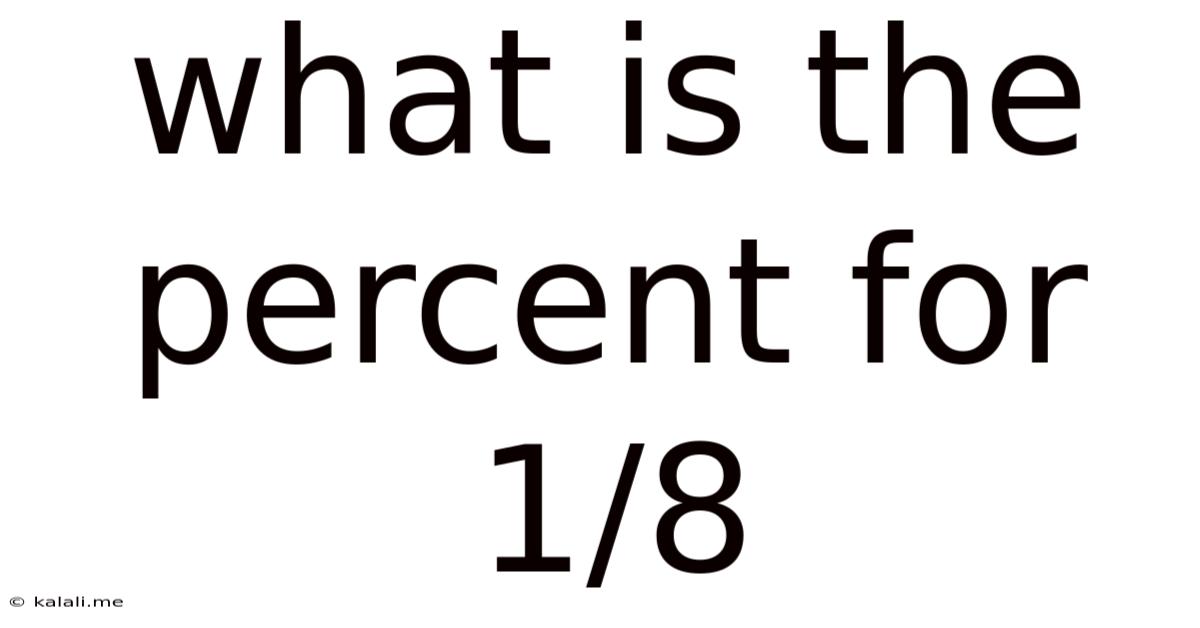What Is The Percent For 1/8
Kalali
Apr 12, 2025 · 4 min read

Table of Contents
What is the Percent for 1/8? A Deep Dive into Fractions and Percentages
Understanding fractions and their percentage equivalents is a fundamental skill in mathematics, with applications spanning numerous fields from everyday budgeting to complex scientific calculations. This comprehensive guide explores the conversion of the fraction 1/8 into a percentage, explaining the process step-by-step and delving into related concepts to solidify your understanding. We'll also look at practical applications and explore how to efficiently handle similar fraction-to-percentage conversions.
Understanding Fractions and Percentages
Before jumping into the specific conversion of 1/8, let's clarify the core concepts. A fraction represents a part of a whole. It's composed of two numbers: the numerator (the top number) and the denominator (the bottom number). The numerator indicates the number of parts you have, while the denominator indicates the total number of equal parts the whole is divided into.
A percentage, on the other hand, expresses a fraction as a portion of 100. The percentage symbol (%) signifies "per hundred." Essentially, a percentage shows how many parts out of 100 represent the fraction.
Converting 1/8 to a Percentage: The Step-by-Step Process
To convert the fraction 1/8 to a percentage, we follow these simple steps:
-
Divide the numerator by the denominator: This gives us the decimal equivalent of the fraction. In this case, 1 divided by 8 equals 0.125.
-
Multiply the decimal by 100: This converts the decimal to a percentage. 0.125 multiplied by 100 equals 12.5.
-
Add the percentage symbol: The final result is 12.5%.
Therefore, 1/8 is equivalent to 12.5%.
Alternative Methods for Conversion
While the above method is straightforward, there are alternative approaches to reach the same result. These methods can be useful for different scenarios and can help improve your understanding of the underlying mathematical principles.
-
Using Proportions: We can set up a proportion to solve for the percentage:
1/8 = x/100
Cross-multiplying, we get:
8x = 100
Solving for x:
x = 100/8 = 12.5
Therefore, x = 12.5%, confirming our previous result.
-
Using Equivalent Fractions: We can find an equivalent fraction with a denominator of 100. While this isn't always practical for all fractions, it can be helpful for simpler cases. In this instance, it's challenging to directly find an equivalent fraction with 100 as the denominator. However, understanding this method reinforces the concept of equivalent fractions.
Practical Applications of 1/8 and 12.5%
The fraction 1/8 and its percentage equivalent, 12.5%, appear in various real-world applications:
-
Cooking and Baking: Recipes often call for fractional amounts of ingredients. Understanding the percentage equivalent can help adjust recipes for larger or smaller portions. For instance, if a recipe calls for 1/8 cup of sugar, it's the same as 12.5% of a cup.
-
Sales and Discounts: Sales often involve percentage discounts. A 12.5% discount on an item means you're paying 87.5% (100% - 12.5%) of the original price.
-
Financial Calculations: Interest rates, loan payments, and investment returns are often expressed as percentages. Understanding the relationship between fractions and percentages can simplify these calculations.
-
Data Analysis: In statistics and data analysis, percentages are frequently used to represent proportions within a dataset. Understanding how fractions translate to percentages is crucial for interpreting data accurately.
-
Geometry and Measurement: When dealing with angles or proportions in geometric figures, understanding the relationship between fractions and percentages can be invaluable. For example, 1/8 of a circle represents a 12.5° angle (360° x 0.125 = 45°).
Extending the Understanding: Working with Other Fractions
The principles used to convert 1/8 to a percentage are applicable to other fractions as well. To convert any fraction to a percentage, simply divide the numerator by the denominator and multiply the result by 100. Let's consider a few examples:
-
1/4: 1 ÷ 4 = 0.25; 0.25 x 100 = 25%; Therefore, 1/4 = 25%
-
3/4: 3 ÷ 4 = 0.75; 0.75 x 100 = 75%; Therefore, 3/4 = 75%
-
1/2: 1 ÷ 2 = 0.5; 0.5 x 100 = 50%; Therefore, 1/2 = 50%
-
2/5: 2 ÷ 5 = 0.4; 0.4 x 100 = 40%; Therefore, 2/5 = 40%
Dealing with More Complex Fractions
While the method remains consistent, fractions with larger numbers may require a calculator for accurate decimal conversions. For instance, converting 17/64 to a percentage would involve dividing 17 by 64 (yielding approximately 0.265625) and then multiplying by 100 to obtain approximately 26.56%. This highlights the importance of using calculators for more complex fractional calculations.
Conclusion: Mastering Fraction-to-Percentage Conversions
Converting fractions to percentages is a fundamental mathematical skill with wide-ranging applications. Understanding the process, including the different methods and their practical uses, empowers you to tackle various numerical challenges effectively. Whether it's adjusting a recipe, calculating a discount, or interpreting data, the ability to convert fractions into percentages proves invaluable in numerous aspects of daily life and professional endeavors. By mastering this skill, you equip yourself with a crucial tool for navigating the numerical world with confidence and precision. Remember that practice is key to solidifying this knowledge; tackling various fractions and their conversions will enhance your understanding and speed.
Latest Posts
Latest Posts
-
What Percent Of 60 Is 39
Apr 18, 2025
-
Cuantos Kilometros Hay En Una Milla
Apr 18, 2025
-
18 Ounces Is How Many Grams
Apr 18, 2025
-
What Is 6 Out Of 10 As A Grade
Apr 18, 2025
-
How Many Feet Is 162 Centimeters
Apr 18, 2025
Related Post
Thank you for visiting our website which covers about What Is The Percent For 1/8 . We hope the information provided has been useful to you. Feel free to contact us if you have any questions or need further assistance. See you next time and don't miss to bookmark.